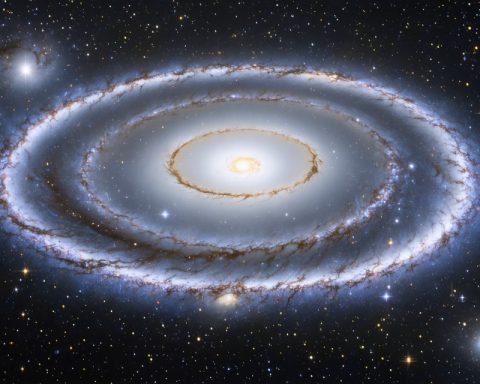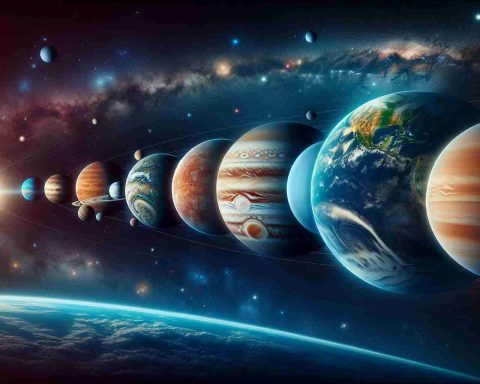- Astronomers discovered a supermassive black hole within the Large Magellanic Cloud (LMC), the closest of its kind outside the Milky Way.
- Hypervelocity stars, traveling over a million miles per hour, led researchers to this hidden black hole.
- The European Space Agency’s Gaia satellite mapped these stars’ paths, unveiling the invisible forces of the black hole.
- This LMC black hole, at approximately 600,000 solar masses, starkly contrasts with the Milky Way’s Sagittarus A at 4 million solar masses.
- The discovery rules out other causes, like supernovae, for the fast-moving stars, indicating a “cosmic slingshot” effect.
- This revelation helps enhance our understanding of the cosmic neighborhood and the universe’s hidden depths.
Astronomers have unveiled an astonishing cosmic revelation: a supermassive black hole lurking in the shadows of the Large Magellanic Cloud (LMC), making it the closest known giant of its kind outside our Milky Way. This celestial behemoth emerged from the shadows through the trails of hypervelocity stars—celestial rockets flung away at speeds exceeding a million miles per hour.
These stars, silent messengers of chaos, seemingly defy the gravitational bonds of the Milky Way, racing towards cosmic freedom. By meticulously tracing these stellar trajectories, much like a detective following the path of a bullet, researchers decrypted their origins. Half of these stars bore the telltale marks of ejection by the Milky Way’s own supermassive black hole. The remainder told a different tale—a story of a hidden monster in the LMC, stealthily influencing its surrounding space.
The tool of this discovery was the European Space Agency’s Gaia satellite, which acts like a cosmic cartographer, mapping the positions and motions of over a billion stars. Gaia’s precision allowed scientists to unearth evidence of invisible forces at play, revealing a hidden dynamo at the heart of the LMC. Like an unseen conductor orchestrating a stellar symphony, the black hole’s gravitational dance with binary star systems sends stars catapulting into the vastness, leaving behind a signature that only an observant eye could detect.
The consequences of this celestial finding extend far beyond mere cataloging. They offer a fresh lens for understanding our cosmic neighborhood. The LMC black hole, weighing in at an estimated 600,000 solar masses, contrasts starkly against our own galaxy’s centerpiece, Sagittarius A, a beast of 4 million solar masses.
The results have ruled out alternative theories for these fast-moving stars. Events such as supernova explosions, which can also eject stars, appear implausible. The patterns clearly indicate the presence of a supermassive black hole executing cosmic slingshots.
In this ever-expanding universe, where distances confound the imagination, these discoveries bring the cosmos nearer, illustrating how the dance of the stars reveals secrets buried in the darkness. The supermassive neighbor in the LMC stands as a reminder of the cosmos’s hidden depths, offering new pathways to explore the marvels beyond our galactic doorstep. Celestial mysteries await those who dare to peer beyond the known, where the stars whisper secrets and the unimaginable becomes reality.
Unveiling the Cosmic Enigma: Discoveries Beyond the Largest Black Hole in the Large Magellanic Cloud
Understanding the Massive Black Hole in the Large Magellanic Cloud
Recently, astronomers have uncovered a cosmic revelation: a supermassive black hole lurking in the Large Magellanic Cloud (LMC), the closest of its kind outside the Milky Way. This discovery, made possible by the European Space Agency’s Gaia satellite, has significant implications for our understanding of the universe. Here’s an in-depth look at the details and implications of this celestial phenomenon.
Key Details of the Discovery
1. Detection via Hypervelocity Stars:
– The supermassive black hole was unveiled through the study of hypervelocity stars—celestial bodies propelled at speeds over a million miles per hour. By tracing their trajectories, astronomers determined that these stars were ejected by gravitational interactions either with the Milky Way’s central black hole or the one in the LMC.
2. Gaia Satellite’s Role:
– Gaia has precisely mapped the positions and movements of over a billion stars, providing the necessary data to identify the influence of the LMC’s concealed supermassive black hole.
3. Mass Comparison:
– The black hole in the LMC is estimated to weigh 600,000 solar masses, significantly less than Sagittarius A* at the center of the Milky Way, which is about 4 million solar masses.
Insights and Predictions
This discovery suggests we might continue finding similar black holes in other nearby galaxies, potentially reshaping the known structure and dynamics of our cosmic neighborhood. It emphasizes the need for continuous exploration and better technology to observe such hidden cosmic phenomena.
Life Hacks: How to Stay Informed on Space Discoveries
1. Subscribe to Astronomy Journals and Magazines: To stay updated, subscribing to platforms like “Sky & Telescope” or “Astronomy Magazine” can provide regular updates and insights.
2. Follow Space Agencies: Following organizations such as the European Space Agency and NASA on social media and their websites keeps you informed of the latest discoveries and missions.
Real-World Implications and Use Cases
– Astrophysics Research: This finding is crucial for astrophysical models that aim to predict the behavior of galaxies and the role of supermassive black holes.
– Space Exploration: These discoveries help shape future missions and research priorities, focusing on understanding galactic dynamics and space-time phenomena.
Pros & Cons Overview
Pros:
– Enhances our understanding of black holes and their influence on galaxy dynamics.
– Provides critical data for exploring gravitational waves and cosmic evolution.
Cons:
– The rarity of such observations means significant resources and time are required.
– There are challenges in differentiating the effects of local galactic black holes and those from others in nearby galaxies.
Controversies & Limitations
– Alternative Ejection Mechanisms: While alternative theories like supernova-induced ejections were discarded, the debate about what other mechanisms might mimic these effects continues.
– Data Limitations: Despite Gaia’s precision, there remain limitations due to measurement accuracy, requiring corroborative data from other observatories.
Conclusion and Actionable Tips
Discoveries like the supermassive black hole in the LMC are reminders of the universe’s uncharted depths. To embrace these cosmic mysteries, stay curious, engage with credible sources, and leverage the power of modern technology and community platforms to further your understanding.
By incorporating these insights and staying engaged with emerging astronomical research, anyone can participate in the journey of space exploration and discovery.

















